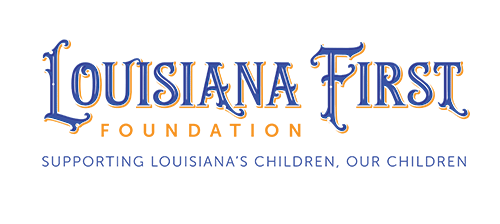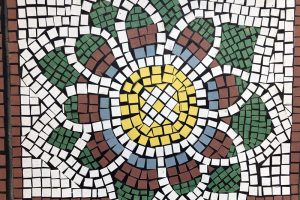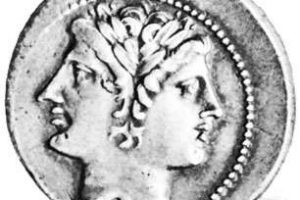NATHALIE ROY
NATHALIE ROY
Glasgow Middle School, East Baton Rouge Parish
Teacher of Roman Technology, Classical Mythology, and Latin
2021 Louisiana State Teacher of the Year
“Making it Work: Looking to the Past to Inspire the Future”
As a Latin and Roman Technology teacher, I often look to the ancient Romans for inspiration in my daily work. The Romans worshipped Janus, the god of beginnings and endings who watched over doorways, bridges, and roads. Because these things simultaneously represented the past (what lay behind) and the future (what lay ahead), Romans saw them as transitions in everyday life. Ancient coins depict the god with two faces, one looking back toward the past and one looking forward to the future. Some linguists think that our first month of January derives its name from this god; thus, as the challenging year of 2020 ends, and another, hopefully, better year begins anew, I find myself reflecting on the past and future of my teaching.
I teach classes that center hands-on making and creativity. Making is an educational movement that encourages tinkering and building to solve problems in the real world. In my Roman Technology class, we reproduce the products and processes of ancient Roman daily life through experimental archaeology and maker projects. Through these engineering and maker challenges, students learn to communicate and collaborate as they think through problems and solve them.
Real-life is the basis of Maker education. Engineers and makers, who solve real-world problems with science, technology, art, and math, often encounter constraints such as cost, location, materials, and time. These constraints, or restrictions, are also an essential part of teaching STEM and making. For example, my students’ constraints might be having only so much cardboard, rubber tubing, and time to complete their designs and prototypes when doing a Roman aqueduct challenge.
Early on, I decided to think of this year’s pandemic as a real-world “constraint,” a problem to be solved. With one semester now done, I’ve realized that the maker mentality I’ve been encouraging in my students is just the spirit I need in myself as a teacher. I ask my students to work within constraints and overcome them all the time. Those constraints often define the product and steer it into new and inspiring directions. Makers are resilient and inventive. As this pandemic semester wore on, I had a eureka moment: I needed to use my maker mentality to conquer the pandemic’s educational challenges. I had to think of the virtual aspect of hands-on teaching as an engineering constraint. It was just one part of a new challenge that I had to learn to overcome. When I started to think like a problem-solving maker, I was able to make progress.
Lesson 1: Use the Constraints to Inspire You
One of the biggest challenges for my hands-on classes was supplies. Because some of my students were learning virtually, and others were learning in person, the two groups would not have equal access to my classroom supplies. Also, students who may plan to be in-person learners could find themselves quarantined at any given moment. How would everyone have equal access to supplies in my classroom?
Using my maker mentality, I assembled kits containing all necessary items for building projects. Each student, whether virtual or in-person, would have a kit from which to work. The students then used the kit materials to build along with me during class time – tongue depressor catapults, paper mosaics, and small cardboard weaving looms were simple projects with a significant impact. The students loved the drama of opening up a small kit of supplies (we called these class sessions our “unbagging videos” modeled on the popular YouTube “unboxing videos” which social media influencers use to create buzz for specific products they want to promote). Many students shared that making things with their own hands in this class was their best experience this semester.
Lesson 2: Use Creative Thinking to Collaborate
Conquering this constraint gave me the confidence to tackle another challenge that arose this past fall: student collaboration. In a face-to-face hands-on class, students usually work through a maker challenge in teams so they can bounce ideas off each other and practice collaboration. Now that some are learning in person and some in their own homes, a new constraint presented itself – how would they collaborate on maker projects?
Our first project of the year was mosaic making. Ancient Romans would have designed and built these floor coverings in teams and worked in real-time to lay down a mosaic floor. Using the maker mentality to conquer this constraint, my students brainstormed and came up with a way to create a large-scale mosaic design together even though we are apart. Each student created one small piece of an extensive work of art – these pieces fit together to make a large-scale floor piece. Even though we couldn’t use our hammers to cut real stone tesserae (we used paper), I’m confident that my students still had a wonderful maker experience. When tasked with solving problems and collaborating to make their own educational experiences, students find those experiences are ever so much richer and memorable.
Lesson 3: Use Making to Heal
Realizing the need for some normalcy this semester, my school formed virtual clubs for our students to participate. These clubs allow students to socialize and share their experiences during the pandemic. Students’ social-emotional learning is just as important as their educational subjects. To help my school community begin to talk about our experiences and start healing, I created the COVID Crochet Club. The club’s simple goal is to learn to crochet, but the real goal is to share our COVID experiences in a no-judgment zone. Every week we meet virtually to crochet scarves made for donations to homeless residents of Baton Rouge who are in need during these cold winter months.
Students can share in virtual anonymity what they are comfortable with without having to reveal their faces or their home life during this maker club’s weekly meetings. This more private format, which generally might be considered a constraint for a club, is now the perfect service-learning experience. Hopefully, this club will bring a little healing to a lot of hurt in our community. Of all the benefits of education, the helping aspect of it is the most powerful. As students come together to make, they also have the opportunity to heal.
Making a New Path
My students are making a new path in this uncertain time – an approach to building, collaborating, and healing. But making is not just for students – adopting a maker mentality is essential for teachers right now. I’m here to tell all educators and leaders – you CAN do this. When I get discouraged about a lesson plan due to COVID constraints, I reread Dale Dougherty’s writings, founder of the Maker Movement. “Makers are playful, resourceful, and experimental. They not only help themselves, but they help others. Makers do well because they can adapt to change as self-directed learners, but they are also agents of change. In this movement, makers are setting their agendas and asking others to join them.”
As I look forward to a new year, I’m grateful for my maker mentality. It continues to help me conquer the challenges of teaching in this uncertain time. I’m MAKING it work. Janus must be watching over me.





